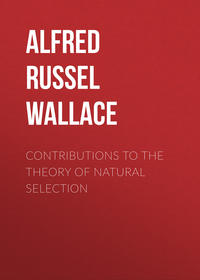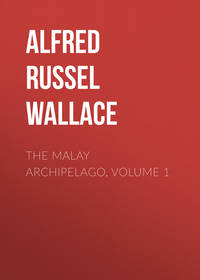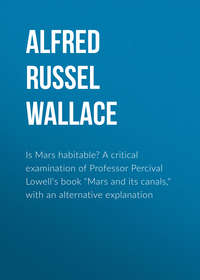 полная версия
полная версияThe Malay Archipelago, Volume 2
In the forests of Ke, arboreal Liliaceae and Pandanaceae abound, and give a character to the vegetation in the more exposed rocky places. Flowers were scarce, and there were not many orchids, but I noticed the fine white butterfly-orchis, Phalaenopsis grandiflora, or a species closely allied to it. The freshness and vigour of the vegetation was very pleasing, and on such an arid rocky surface was a sure indication of a perpetually humid climate. Tall clean trunks, many of them buttressed, and immense trees of the fig family, with aerial roots stretching out and interlacing and matted together for fifty or a hundred feet above the ground, were the characteristic features; and there was an absence of thorny shrubs and prickly rattans, which would have made these wilds very pleasant to roam in, had it not been for the sharp honeycombed rocks already alluded to. In damp places a fine undergrowth of broadleaved herbaceous plants was found, about which swarmed little green lizards, with tails of the most "heavenly blue," twisting in and out among the stalks and foliage so actively that I often caught glimpses of their tails only, when they startled me by their resemblance to small snakes. Almost the only sounds in these primeval woods proceeded from two birds, the red lories, who utter shrill screams like most of the parrot tribe, and the large green nutmeg-pigeon, whose voice is either a loud and deep boom, like two notes struck upon a very large gong, or sometimes a harsh toad-like croak, altogether peculiar and remarkable. Only two quadrupeds are said by the natives to inhabit the island—a wild pig and a Cuscus, or Eastern opossum, of neither of which could I obtain specimens.
The insects were more abundant, and very interesting. Of butterflies I caught thirty-five species, most of them new to me, and many quite unknown in European collections. Among them was the fine yellow and black Papilio euchenor, of which but few specimens had been previously captured, and several other handsome butterflies of large size, as well as some beautiful little "blues," and some brilliant dayflying moths. The beetle tribe were less abundant, yet I obtained some very fine and rare species. On the leaves of a slender shrub in an old clearing I found several fine blue and black beetles of the genus Eupholus, which almost rival in beauty the diamond beetles of South America. Some cocoa-nut palms in blossom on the beach were frequented by a fine green floral beetle (Lomaptera) which, when the flowers were shaken, flew off like a small swarm of bees. I got one of our crew to climb up the tree, and he brought me a good number in his hand; and seeing they were valuable, I sent him up again with my net to shake the flowers into, and thus secured a large quantity. My best capture, however, was the superb insect of the Buprestis family, already mentioned as having been obtained from the natives, who told me they found it in rotten trees in the mountains.
In the forest itself the only common and conspicuous coleoptera were two tiger beetles. One, Therates labiata, was much larger than our green tiger beetle, of a purple black colour, with green metallic glosses, and the broad upper lip of a bright yellow. It was always found upon foliage, generally of broad-leaned herbaceous plants, and in damp and gloomy situations, taking frequent short flights from leaf to leaf, and preserving an alert attitude, as if always looking out for its prey. Its vicinity could be immediately ascertained, often before it was seen, by a very pleasant odour, like otto of roses, which it seems to emit continually, and which may probably be attractive to the small insects on which it feeds. The other, Tricondyla aptera, is one of the most curious forms in the family of the Cicindelidae, and is almost exclusively confined to the Malay islands. In shape it resembles a very large ant, more than an inch long, and of a purple black colour. Like an ant also it is wingless, and is generally found ascending trees, passing around the trunks in a spiral direction when approached, to avoid capture, so that it requires a sudden run and active fingers to secure a specimen. This species emits the usual fetid odour of the ground beetles. My collections during our four days' stay at Ke were as follow:—Birds, 13 species; insects, 194 species; and 3 kinds of land-shells.
There are two kinds of people inhabiting these islands—the indigenes, who have the Papuan characters strongly marked, and who are pagans; and a mixed race, who are nominally Mahometans, and wear cotton clothing, while the former use only a waist cloth of cotton or bark. These Mahometans are said to have been driven out of Banda by the early European settlers. They were probably a brown race, more allied to the Malays, and their mixed descendants here exhibit great variations of colour, hair, and features, graduating between the Malay and Papuan types. It is interesting to observe the influence of the early Portuguese trade with these countries in the words of their language, which still remain in use even among these remote and savage islanders. "Lenco" for handkerchief, and "faca" for knife, are here used to the exclusion of the proper Malay terms. The Portuguese and Spaniards were truly wonderful conquerors and colonizers. They effected more rapid changes in the countries they conquered than any other nations of modern times, resembling the Romans in their power of impressing their own language, religion, and manners on rode and barbarous tribes.
The striking contrast of character between these people and the Malays is exemplified in many little traits. One day when I was rambling in the forest, an old man stopped to look at me catching an insect. He stood very quiet till I had pinned and put it away in my collecting box, when he could contain himself no longer, but bent almost double, and enjoyed a hearty roar of laughter. Every one will recognise this as a true negro trait. A Malay would have stared, and asked with a tone of bewilderment what I was doing, for it is but little in his nature to laugh, never heartily, and still less at or in the presence of a stranger, to whom, however, his disdainful glances or whispered remarks are less agreeable than the most boisterous open expression of merriment. The women here were not so much frightened at strangers, or made to keep themselves so much secluded as among the Malay races; the children were more merry and had the "nigger grin," while the noisy confusion of tongues among the men, and their excitement on very ordinary occasions, are altogether removed from the general taciturnity and reserve of the Malay.
The language of the Ke people consists of words of one, two, or three syllables in about equal proportions, and has many aspirated and a few guttural sounds. The different villages have slight differences of dialect, but they are mutually intelligible, and, except in words that have evidently been introduced during a long-continued commercial intercourse, seem to have no affinity whatever with the Malay languages.
Jan. 6th.-The small boats being finished, we sailed for Aru at 4 P.M., and as we left the shores of Ke had a line view of its rugged and mountainous character; ranges of hills, three or four thousand feet high, stretching southwards as far as the eye could reach, everywhere covered with a lofty, dense, and unbroken forest. We had very light winds, and it therefore took us thirty hours to make the passage of sixty miles to the low, or flat, but equally forest-covered Aru Islands, where we anchored in the harbour of Dobbo at nine in the evening of the next day.
My first voyage in a prau being thus satisfactorily terminated, I must, before taking leave of it for some months, bear testimony to the merits of the queer old-world vessel. Setting aside all ideas of danger, which is probably, after all, not more than in any other craft, I must declare that I have never, either before or since, made a twenty days' voyage so pleasantly, or perhaps, more correctly speaking, with so little discomfort. This I attribute chiefly to having my small cabin on deck, and entirely to myself, to having my own servants to wait upon me, and to the absence of all those marine-store smells of paint, pitch, tallow, and new cordage, which are to me insupportable. Something is also to be put down to freedom from all restraint of dress, hours of meals, &c., and to the civility and obliging disposition of the captain. I had agreed to have my meals with him, but whenever I wished it I had them in my own berth, and at what hours I felt inclined. The crew were all civil and good-tempered, and with very little discipline everything went on smoothly, and the vessel was kept very clean and in pretty good order, so that on the whole I was much delighted with the trip, and was inclined to rate the luxuries of the semi-barbarous prau as surpassing those of the most magnificent screw-steamer, that highest result of our civilisation.
CHAPTER XXX. THE ARU ISLANDS—RESIDENCE IN DOBBO
(JANUARY TO MARCH 1857.)On the 8th of January, 1857, I landed at Dobbo, the trading settlement of the Bugis and Chinese, who annually visit the Aru Islands. It is situated on the small island of Wamma, upon a spit of sand which projects out to the north, and is just wide enough to contain three rows of houses. Though at first sight a most strange and desolate-looking place to build a village on, it has many advantages. There is a clear entrance from the west among the coral reefs that border the land, and there is good anchorage for vessels, on one side of the village or the other, in both the east and west monsoons. Being fully exposed to the sea-breezes in three directions it is healthy, and the soft sandy heath offers great facilities for hauling up the praus, in order to secure them from sea-worms and prepare them for the homeward voyage. At its southern extremity the sand-bank merges in the beach of the island, and is backed by a luxuriant growth of lofty forest. The houses are of various sizes, but are all built after one pattern, being merely large thatched sheds, a small portion of which, next the entrance, is used as a dwelling, while the rest is parted oft; and often divided by one or two floors, in order better to stow away merchandise and native produce.
As we had arrived early in the season, most of the houses were empty, and the place looked desolate in the extreme—the whole of the inhabitants who received us on our landing amounting to about half-a-dozen Bugis and Chinese. Our captain, Herr Warzbergen, had promised to obtain a house for me, but unforeseen difficulties presented themselves. One which was to let had no roof; and the owner, who was building it on speculation, could not promise to finish it in less than a month. Another, of which the owner was dead, and which I might therefore take undisputed possession of as the first comer, wanted considerable repairs, and no one could be found to do the work, although about four times its value was offered. The captain, therefore, recommended me to take possession of a pretty good house near his own, whose owner was not expected for some weeks; and as I was anxious to be on shore, I immediately had it cleared out, and by evening had all my things housed, and was regularly installed as an inhabitant of Dobbo. I had brought with me a cane chair, and a few light boards, which were soon rigged up into a table and shelves. A broad bamboo bench served as sofa and bedstead, my boxes were conveniently arranged, my mats spread on the floor, a window cut in the palm-leaf wall to light my table, and though the place was as miserable and gloomy a shed as could be imagined, I felt as contented as if I had obtained a well-furnished mansion, and looked forward to a month's residence in it with unmixed satisfaction.
The next morning, after an early breakfast, I set off to explore the virgin forests of Aru, anxious to set my mind at rest as to the treasures they were likely to yield, and the probable success of my long-meditated expedition. A little native imp was our guide, seduced by the gift of a German knife, value three-halfpence, and my Macassar boy Baderoon brought his chopper to clear the path if necessary.
We had to walk about half a mile along the beach, the ground behind the village being mostly swampy, and then turned into the forest along a path which leads to the native village of Wamma, about three miles off on the other side of the island. The path was a narrow one, and very little used, often swampy and obstructed by fallen trees, so that after about a mile we lost it altogether, our guide having turned back, and we were obliged to follow his example. In the meantime, however, I had not been idle, and my day's captures determined the success of my journey in an entomological point of view. I had taken about thirty species of butterflies, more than I had ever captured in a day since leaving the prolific banks of the Amazon, and among them were many most rare and beautiful insects, hitherto only known by a few specimens from New Guinea. The large and handsome spectre butterfly, Hestia durvillei; the pale-winged peacock butterfly, Drusilla catops; and the most brilliant and wonderful of the clear-winged moths, Cocytia durvillei, were especially interesting, as well, as several little "blues," equalling in brilliancy and beauty anything the butterfly world can produce. In the other groups of insects I was not so successful, but this was not to be wondered at in a mere exploring ramble, when only what is most conspicuous and novel attracts the attention. Several pretty beetles, a superb "bug," and a few nice land-shells were obtained, and I returned in the afternoon well satisfied with my first trial of the promised land.
The next two days were so wet and windy that there was no going out; but on the succeeding one the sun shone brightly, and I had the good fortune to capture one of the most magnificent insects the world contains, the great bird-winged butterfly, Ornithoptera Poseidon. I trembled with excitement as I saw it coming majestically towards me, and could hardly believe I had really succeeded in my stroke till I had taken it out of the net and was gazing, lost in admiration, at the velvet black and brilliant green of its wings, seven inches across, its bolder body, and crimson breast. It is true I had seen similar insects in cabinets at home, but it is quite another thing to capture such oneself-to feel it struggling between one's fingers, and to gaze upon its fresh and living beauty, a bright gem shirring out amid the silent gloom of a dark and tangled forest. The village of Dobbo held that evening at least one contented man.
Jan. 26th.—Having now been here a fortnight, I began to understand a little of the place and its peculiarities. Praus continually arrived, and the merchant population increased almost daily. Every two or three days a fresh house was opened, and the necessary repairs made. In every direction men were bringing in poles, bamboos, rattans, and the leaves of the nipa palm to construct or repair the walls, thatch, doors, and shutters of their houses, which they do with great celerity. Some of the arrivals were Macassar men or Bugis, but more from the small island of Goram, at the east end of Ceram, whose inhabitants are the petty traders of the far East. Then the natives of Aru come in from the other side of the islands (called here "blakang tana," or "back of the country") with the produce they have collected during the preceding six months, and which they now sell to the traders, to some of whom they are most likely in debt.
Almost all, or I may safely say all, the new arrivals pay me a visit, to see with their own eyes the unheard-of phenomenon of a person come to stay at Dobbo who does not trade! They have their own ideas of the uses that may possibly be made of stuffed birds, beetles, and shells which are not the right shells—that is, "mother-of-pearl." They every day bring me dead and broken shells, such as I can pick up by hundreds on the beach, and seem quite puzzled and distressed when I decline them. If, however, there are any snail shells among a lot, I take them, and ask for more—a principle of selection so utterly unintelligible to them, that they give it up in despair, or solve the problem by imputing hidden medical virtue to those which they see me preserve so carefully.
These traders are all of the Malay race, or a mixture of which Malay is the chef ingredient, with the exception of a few Chinese. The natives of Aru, on the other hand, are, Papuans, with black or sooty brown skims, woolly or frizzly hair, thick-ridged prominent noses, and rather slender limbs. Most of them wear nothing but a waist-cloth, and a few of them may be seen all day long wandering about the half-deserted streets of Dobbo offering their little bit of merchandise for sale.
Living in a trader's house everything is brought to me as well as to the rest,—bundles of smoked tripang, or "beche de mer," looking like sausages which have been rolled in mud and then thrown up the chimney; dried sharks' fins, mother-of-pearl shells, as well as birds of Paradise, which, however, are so dirty and so badly preserved that I have as yet found no specimens worth purchasing. When I hardly look at the articles, and make no offer for them, they seem incredulous, and, as if fearing they have misunderstood me, again offer them, and declare what they want in return—knives, or tobacco, or sago, or handkerchiefs. I then have to endeavour to explain, through any interpreter who may be at hand, that neither tripang nor pearl oyster shells have any charms for me, and that I even decline to speculate in tortoiseshell, but that anything eatable I will buy—fish, or turtle, or vegetables of any sort. Almost the only food, however, that we can obtain with any regularity, are fish and cockles of very good quality, and to supply our daily wants it is absolutely necessary to be always provided with four articles—tobacco, knives, sago-cakes, and Dutch copper doits—because when the particular thing asked for is not forthcoming, the fish pass on to the next house, and we may go that day without a dinner. It is curious to see the baskets and buckets used here. The cockles are brought in large volute shells, probably the Cymbium ducale, while gigantic helmet-shells, a species of Cassis, suspended by a rattan handle, form the vessels in which fresh water is daily carried past my door. It is painful to a naturalist to see these splendid shells with their inner whorls ruthlessly broken away to fit them for their ignoble use.
My collections, however, got on but slowly, owing to the unexpectedly bad weather, violent winds with heavy showers having been so continuous as only to give me four good collecting days out of the first sixteen I spent here. Yet enough had been collected to show me that with time and fine weather I might expect to do something good. From the natives I obtained some very fine insects and a few pretty land-shells; and of the small number of birds yet shot more than half were known New Guinea species, and therefore certainly rare in European collections, while the remainder were probably new. In one respect my hopes seemed doomed to be disappointed. I had anticipated the pleasure of myself preparing fine specimens of the Birds of Paradise, but I now learnt that they are all at this season out of plumage, and that it is in September and October that they have the long plumes of yellow silky feathers in full perfection. As all the praus return in July, I should not be able to spend that season in Aru without remaining another whole year, which was out of the question. I was informed, however, that the small red species, the "King Bird of Paradise," retains its plumage at all seasons, and this I might therefore hope to get.
As I became familiar with the forest scenery of the island, I perceived it to possess some characteristic features that distinguished it from that of Borneo and Malacca, while, what is very singular and interesting, it recalled to my mind the half-forgotten impressions of the forests of Equatorial America. For example, the palms were much more abundant than I had generally found them in the East, more generally mingled with the other vegetation, more varied in form and aspect, and presenting some of those lofty and majestic smooth-stemmed, pinnate-leaved species which recall the Uauassu (Attalea speciosa) of the Amazon, but which I had hitherto rarely met with in the Malayan islands.
In animal life the immense number and variety of spiders and of lizards were circumstances that recalled the prolific regions of south America, more especially the abundance and varied colours of the little jumping spiders which abound on flowers and foliage, and are often perfect gems of beauty. The web-spinning species were also more numerous than I had ever seen them, and were a great annoyance, stretching their nets across the footpaths just about the height of my face; and the threads composing these are so strong and glutinous as to require much trouble to free oneself from them. Then their inhabitants, great yellow-spotted monsters with bodies two inches long, and legs in proportion, are not pleasant to o run one's nose against while pursuing some gorgeous butterfly, or gazing aloft in search of some strange-voiced bird. I soon found it necessary not only to brush away the web, but also to destroy the spinner; for at first, having cleared the path one day, I found the next morning that the industrious insects had spread their nets again in the very same places.
The lizards were equally striking by their numbers, variety, and the situations in which they were found. The beautiful blue-tailed species so abundant in Ke was not seen here. The Aru lizards are more varied but more sombre in their colours—shades of green, grey, brown, and even black, being very frequently seen. Every shrub and herbaceous plant was alive with them, every rotten trunk or dead branch served as a station for some of these active little insect-hunters, who, I fear, to satisfy their gross appetites, destroy many gems of the insect world, which would feast the eyes and delight the heart of our more discriminating entomologists. Another curious feature of the jungle here was the multitude of sea-shells everywhere met with on the ground and high up on the branches and foliage, all inhabited by hermit-crabs, who forsake the beach to wander in the forest. I lave actually seen a spider carrying away a good-sized shell and devouring its (probably juvenile) tenant. On the beach, which I had to walls along every morning to reach the forest, these creatures swarmed by thousands. Every dead shell, from the largest to the most minute, was appropriated by them. They formed small social parties of ten or twenty around bits of stick or seaweed, but dispersed hurriedly at the sound of approaching footsteps. After a windy night, that nasty-looking Chinese delicacy the sea-slug was sometimes thrown up on the beach, which was at such times thickly strewn with some of the most beautiful shells that adorn our cabinets, along with fragments and masses of coral and strange sponges, of which I picked up more than twenty different sorts. In many cases sponge and coral are so much alike that it is only on touching them that they can be distinguished. Quantities of seaweed, too, are thrown up; but strange as it may seem, these are far less beautiful and less varied than may be found on any favourable part of our own coasts.
The natives here, even those who seem to be of pare Papuan race, were much more reserved and taciturn than those of Ke. This is probably because I only saw them as yet among strangers and in small parties, One must see the savage at home to know what he really is. Even here, however, the Papuan character sometimes breaks out. Little boys sing cheerfully as they walk along, or talk aloud to themselves (quite a negro characteristic); and try all they can, the men cannot conceal their emotions in the true Malay fashion. A number of them were one day in my house, and having a fancy to try what sort of eating tripang would be, I bought a couple, paying for them with such an extravagant quantity of tobacco that the seller saw I was a green customer. He could not, however, conceal his delight, but as he smelt the fragrant weed, and exhibited the large handful to his companions, he grinned and twisted and gave silent chuckles in a most expressive pantomime. I had often before made the same mistake in paying a Malay for some trifle. In no case, however, was his pleasure visible on his countenance—a dull and stupid hesitation only showing his surprise, which would be exhibited exactly in the same way whether he was over or under paid. These little moral traits are of the greatest interest when taken in connexion with physical features. They do not admit of the same ready explanation by external causes which is so frequently applied to the latter. Writers on the races of mankind have too often to trust to the information of travellers who pass rapidly from country to country, and thus have few opportunities of becoming acquainted with peculiarities of national character, or even of ascertaining what is really the average physical conformation of the people. Such are exceedingly apt to be deceived in places where two races have long, intermingled, by looking on intermediate forms and mixed habits as evidences of a natural transition from one race to the other, instead of an artificial mixture of two distinct peoples; and they will be the more readily led into this error if, as in the present case, writers on the subject should have been in the habit of classing these races as mere varieties of one stock, as closely related in physical conformation as from their geographical proximity one might suppose they ought to be. So far as I have yet seen, the Malay and Papuan appear to be as widely separated as any two human races that exist, being distinguished by physical, mental, and moral characteristics, all of the most marked and striking kind.









